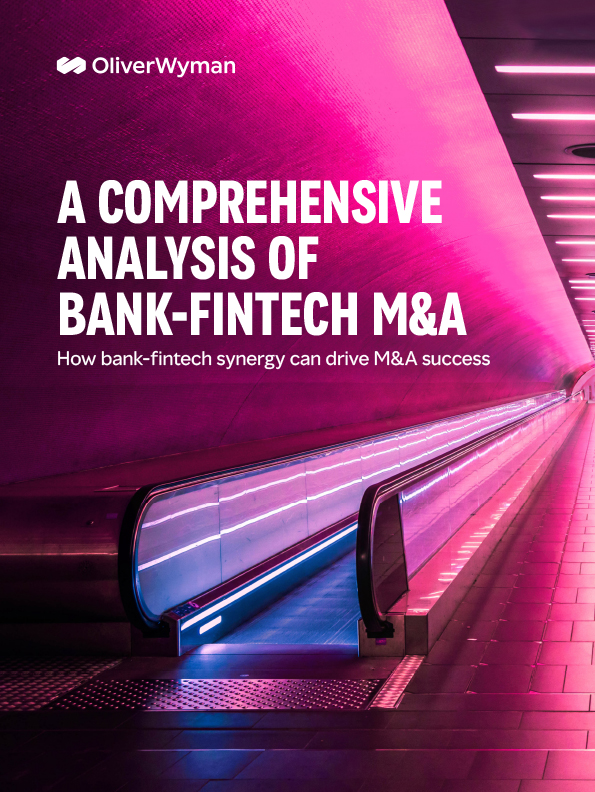Chapter 3
Key considerations for banks exploring fintech M&A
Banks should identify top M&A priorities prior to scanning for fintech targets and evaluate synergies that can be achieved through a deal versus partnering or building solutions in house. In our experience, banks evaluate fintech M&A across five dimensions (Exhibit 5).
Exhibit 5: Reasons why banks consider acquiring fintechs
Technology and innovation discipline
The best and most prolific bank acquirers build their skillsets over time, creating capabilities layer by layer across multiple functions needed to support the M&A process. For example, multiple GSIBs approach corporate development with dedicated teams within each line of business, underpinned by a centralized M&A team that leads the transaction in partnership with technology, product, and multiple diligence teams. Regional banks have followed suit and now often embed inorganic growth teams within the business itself.
When banks find fintech targets with unique technology, M&A can be an accelerator of innovation, product, and business growth. For example, JPMorgan Chase’s acquisition of OpenInvest in 2021 increased its ability to serve retail and institutional investors with a scalable, value-based investment offering.
Digital capabilities in fintech
Banks have invested significantly to create parity across digital customer experience, design, engineering, and research capabilities with best-in-class startups. Elegant user experiences from across financial services businesses are captured and tested in customer focus groups and resulting product releases are pushed frequently.
In some instances, fintech acquisitions augment digital banking capabilities. For example, Capital One acquired price-tracking app Paribus in 2016. Paribus’s customer engagement and product design capabilities enabled the bank to add the Price Protection feature to the bank’s credit cards, attracting additional retail partnerships and helping drive customer retention.
Scale and distribution advantages
The number of bank customers, ranging from GSIBs to regionals and even many credit unions far exceed that of all but a handful of fintechs. This translates into pricing power, vendor and partner influence, and distribution across channels. Fintechs that can materially augment these advantages are rare, leading to tuck-in and use-case driven M&A.
US Bank’s acquisition of Bento for Business in 2021 leveraged the bank’s brand and scale to enhance a key product in the SMB segment and deepen customer engagement. Bento’s platform helps small businesses manage physical and digital card payments from mobile or the web, and may complement existing US Bank tools for business owners.
In some instances, fintechs can help unlock key customer segments. For example, in 2021, Fifth Third acquired Provide’s customer base of dentists, veterinarians, and other healthcare practitioners. Fifth Third used the acquisition to grow market share in lending, banking, and issuing cards to this strategically prioritized and growing segment.
Value preservation
As fintech valuations decline, banks can choose from a larger pool of potential fintech M&A targets. However, there are valuation discrepancies between banks and fintechs. Banks tend to value fintechs based on profitability and immediate bottom-line impact; fintechs commonly value themselves on future growth metrics and revenue. This misalignment can lead to fintechs being perceived as overvalued by banks calculating deal metrics based on cash flow multiples. In addition, banks focus on accretive value. There is no guarantee that an acquired fintech’s value won’t plummet the day after deal-closing or end up being written off in the future.
Navigating bank-fintech culture
In bank-fintech M&A, challenges arise from the gulf between startup culture and traditional banking culture. Banks should weigh cultural tradeoffs with perceived business benefits of fintech acquisition targets.
As one founder with a previous bank exit noted, “Most founders have no interest in being at a bank. And they can try to withstand as long as possible… and they try to carve out spaces, but in the end, they will need to assimilate.”
This underscores the divergence in mindset and approach between startups and banks. While startups thrive on disruption, agility, and independence, eventually they must adopt their acquirers’ ways of doing business, learn to speak the language of banks and bridge operating differences.
Striking the delicate balance between preserving the innovative spirit of startups and integrating into the non-negotiable regulatory and operational frameworks of banks remains a critical challenge to successful M&A.
Other considerations in bank-fintech M&A
Industry experts agree that banks purchase fintechs primarily for the commercial purposes explored above. Additional considerations driving acquisition might also include credit exposure diversification, cost efficiencies, and buy-and-hold of appreciating assets. These considerations tend to be edge-cases in bank-fintech M&A and we do not evaluate them further.











